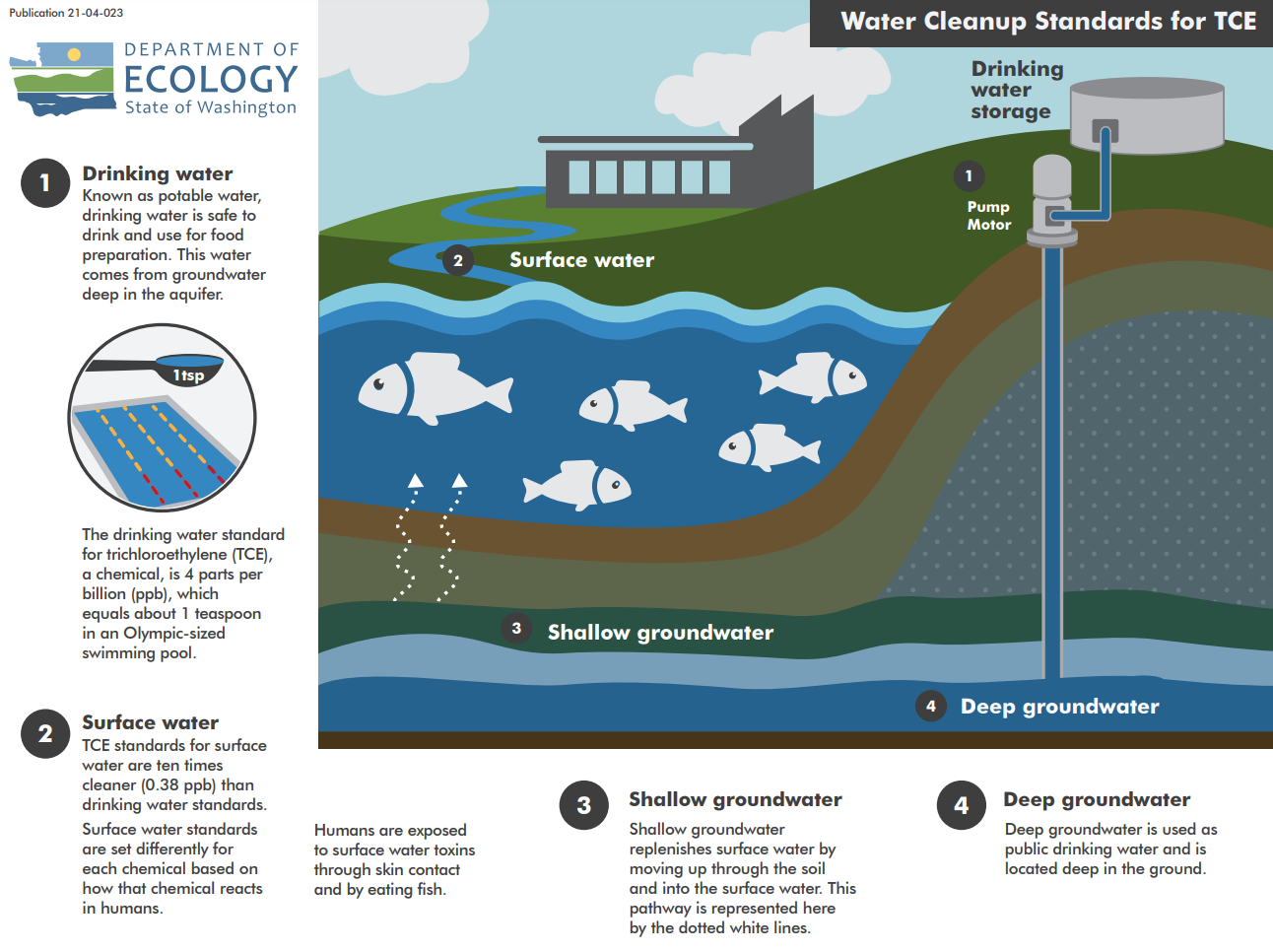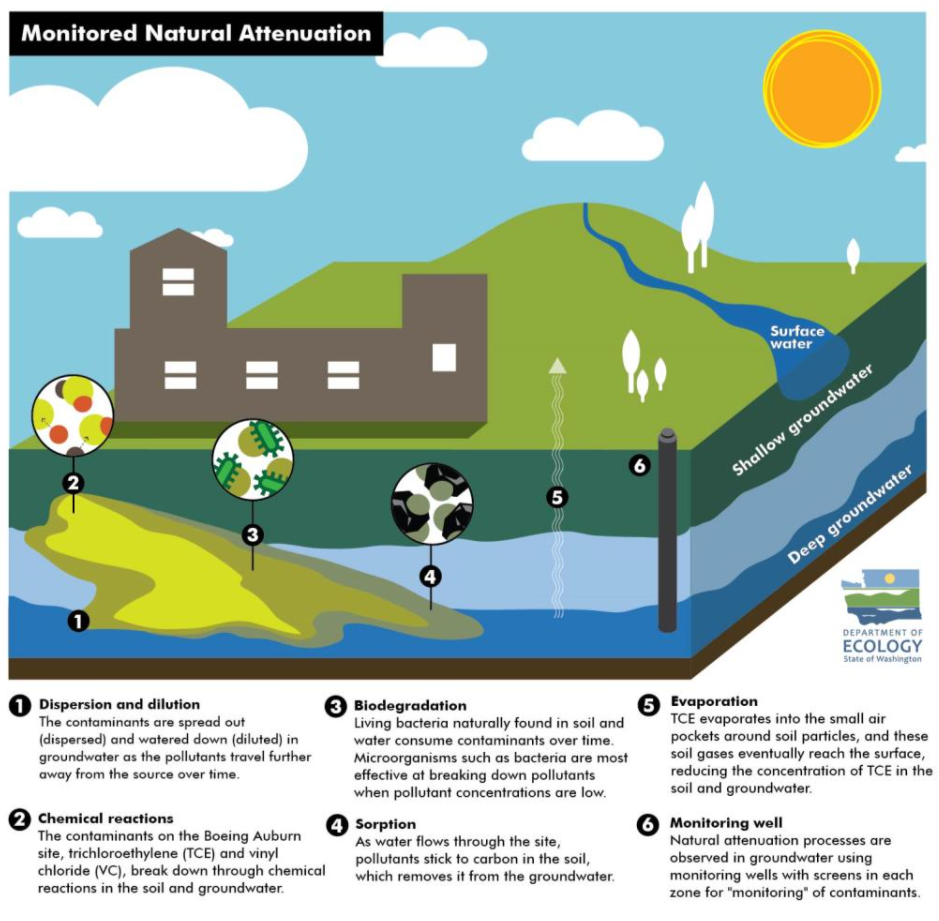Boeing Auburn Cleanup Site
We oversee the cleanup process that Boeing conducts at its Auburn facility, 700 15th St. SW. Low levels of soil and groundwater contamination at this site extend more than a mile north and northwest of Boeing’s property.
How did the site get contaminated?
Boeing treated and stored hazardous waste at its Auburn facility where it produces parts for commercial aircraft.
Contamination on the property includes:
- Traces of metals
- Petroleum hydrocarbons
- Solvent chemicals such as TCE (trichloroethylene), a liquid chemical used to clean metal parts
While Boeing Auburn no longer uses TCE, the use of this chemical to clean metal parts between the mid-1960s to the 1990s led to the contamination we see today. Boeing will carry out a cleanup plan that we approve as part of the Model Toxics Control Act cleanup process.
What did we test for contamination?
Groundwater moves slowly through soil, sand, and rocks underground. While groundwater contamination is above cleanup levels, the concentrations are low and do not affect people, pets, or the environment. Low level TCE contamination in groundwater extends for more than a mile north and northwest of the Boeing Auburn facility.
Boeing evaluated site-wide groundwater contamination and potential cleanup options in the feasibility and supplemental feasibility studies. These studies compare cleanup methods.
The cleanup methods selected were:
- Bioremediation.
- Natural attenuation.
Boeing is implementing the cleanup action plan.
Even though soil contamination levels are low and not a risk to human health and the environment, there are a few areas where soil contamination is above cleanup levels. Where soils are above cleanup levels they will be excavated and disposed of as hazardous waste.
Soils on-site were contaminated with low levels of petroleum hydrocarbons, cyanide, and metals (such as cadmium and copper).
Surface water is safe. Boeing collected and tested hundreds of water samples. None contained toxic chemicals at levels that affect human health.
Samples were collected from:
- Government Canal
- Stormwater collection ditch on Chicago Ave
- O Street wetland
- Outlet Collection stormwater ponds and collection ditch
- Auburn 400 ponds
- Mill Creek and various wetlands associated with Mill Creek, including Auburn Environmental Park
Boeing continues to evaluate groundwater across the site.
Breathing the air near the site is safe. Air samples taken from inside and outside homes and buildings were reviewed by the Department of Health (DOH).
- Read about the results of DOH's City of Algona Indoor Air Results.
We monitor the levels of volatile contaminants in groundwater (chemicals that contain carbon and become a gas at room temperature). If these contaminant levels rise in groundwater, we can test more indoor air samples to make sure it remains safe.
Groundwater cleanup standards for TCE
This infographic shows the different trichloroethylene (TCE) cleanup standards for drinking water (groundwater) and surface water.
Monitored natural attenuation
Monitored natural attenuation (MNA) involves closely monitoring the natural breakdown of chemicals on a contaminated site until cleanup standards are reached.
- Click the image to enlarge.
- Click for plain text explanation.
Bioremediation
Map of areas considered for bioremediation.
At the Boeing Auburn site, bioremediation has been used successfully to break down chemicals in contaminated groundwater.
For more information:
History of site cleanup
In 2002, we and Boeing studied the contamination and developed a plan for cleanup. In 2009, we found that the groundwater contamination had spread off Boeing's property and required more sampling to find out how far the contamination had spread. Here is the timeline of what's been done and where we are in the cleanup process.
Frequently asked questions
Related links
Contact information
Li Ma
Site Manager
li.ma@ecy.wa.gov
206-594-0051
Janelle Anderson
Public Involvement Coordinator
janelle.anderson@ecy.wa.gov
206-594-0053



